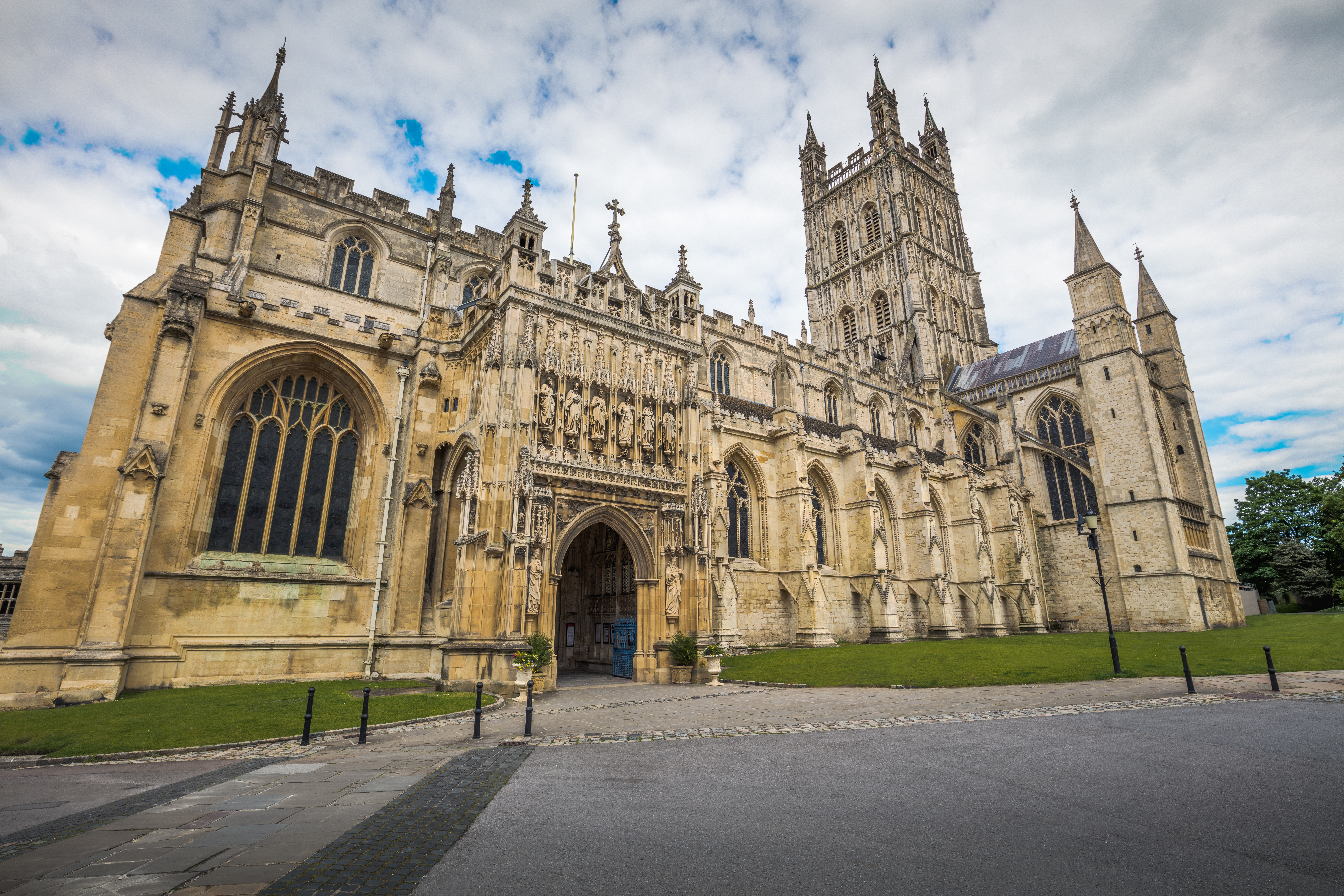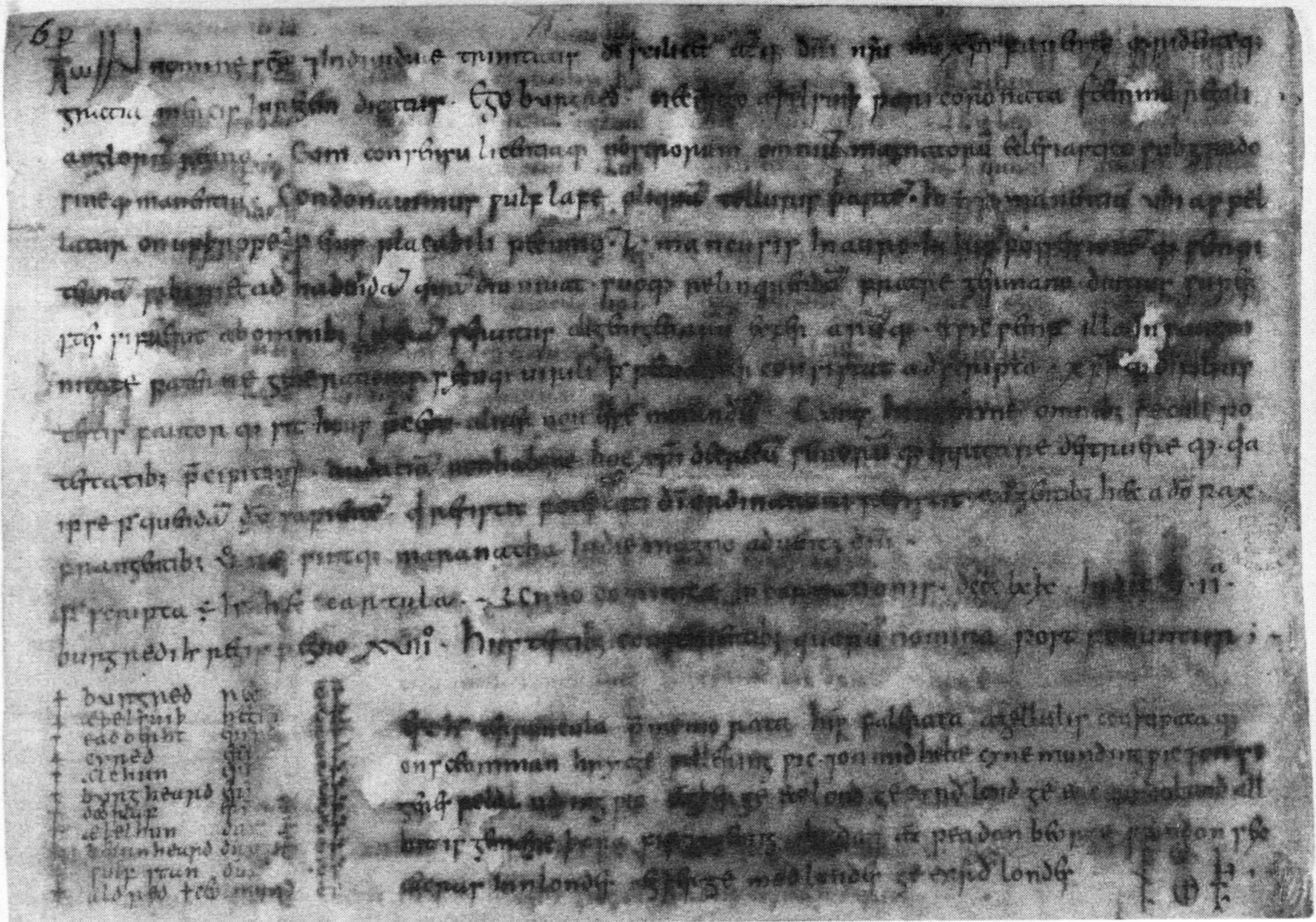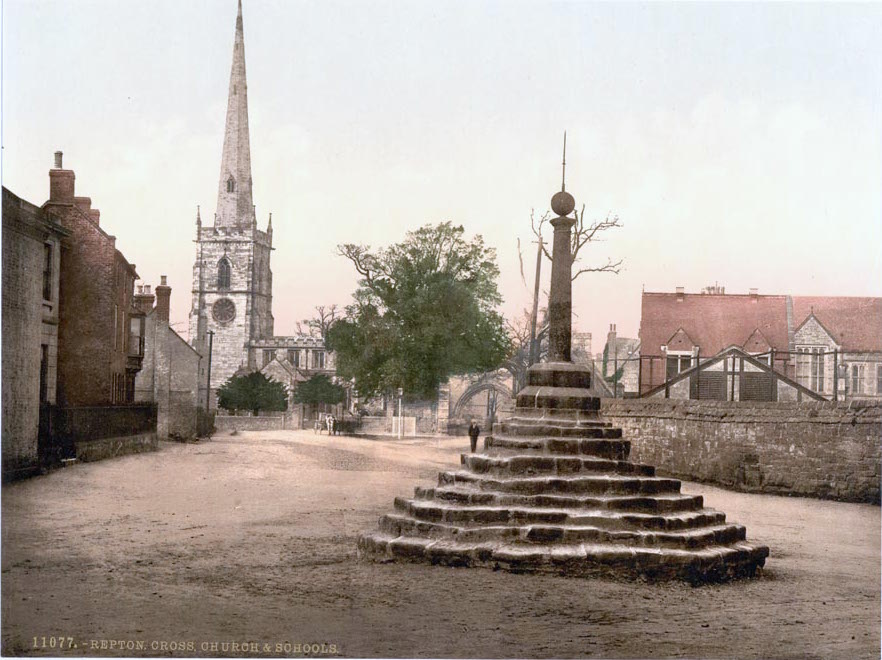|
Burghal Hidage
The Burghal Hidage () is an Anglo-Saxon document providing a list of over thirty fortified places (burhs), the majority being in the ancient Kingdom of Wessex, and the taxes (recorded as numbers of hides) assigned for their maintenance.Hill/ Rumble. The Defence of Wessex. p. 5 The document, so named by Frederic William Maitland in 1897, survives in two versions of medieval and early modern date. Version A, Cotton Otho B.xi was badly damaged in a fire at Ashburnham House in Westminster in 1731, but the body of the text survives in a transcript made by the antiquary Laurence Nowell in 1562. Version B survives as a composite part of seven further manuscripts, usually given the title ''De numero hydarum Anglie in Britannia''.Hill/ Rumble. The Defence of Wessex. p. 14 There are several discrepancies in the lists recorded in the two versions of the document: Version A includes references to Burpham, Wareham and Bridport but omits Shaftesbury and Barnstaple which are listed in Version ... [...More Info...] [...Related Items...] OR: [Wikipedia] [Google] [Baidu] |
Anglo-Saxon Burhs
The Anglo-Saxons, in some contexts simply called Saxons or the English, were a cultural group who spoke Old English and inhabited much of what is now England and south-eastern Scotland in the Early Middle Ages. They traced their origins to Germanic settlers who became one of the most important cultural groups in Britain by the 5th century. The Anglo-Saxon period in Britain is considered to have started by about 450 and ended in 1066, with the Norman Conquest. Although the details of their early settlement and political development are not clear, by the 8th century an Anglo-Saxon cultural identity which was generally called had developed out of the interaction of these settlers with the existing Romano-British culture. By 1066, most of the people of what is now England spoke Old English, and were considered English. Viking and Norman invasions changed the politics and culture of England significantly, but the overarching Anglo-Saxon identity evolved and remained dominant even ... [...More Info...] [...Related Items...] OR: [Wikipedia] [Google] [Baidu] |
Danegeld
Danegeld (; "Danish tax", literally "Dane yield" or tribute) was a tax raised to pay tribute or Protection racket, protection money to the Viking raiders to save a land from being ravaged. It was called the ''geld'' or ''gafol'' in eleventh-century sources. It was characteristic of royal policy in both England and Francia during the ninth through eleventh centuries, collected both as Tribute, tributary, to buy off the attackers, and as stipendiary, to pay the defensive forces. The term ''Danegeld'' did not appear until the late eleventh century. In History of Anglo-Saxon England, Anglo-Saxon England tribute payments to the Danes was known as ''gafol'' and the levy raised to support the standing army, for the defence of the realm, was known as ''heregeld'' (army-tax). England In England, a Hide (unit), hide was notionally an area of land sufficient to support one family; however their true size and economic value varied enormously. The hide's purpose was as a unit of assessmen ... [...More Info...] [...Related Items...] OR: [Wikipedia] [Google] [Baidu] |
Gloucester
Gloucester ( ) is a cathedral city, non-metropolitan district and the county town of Gloucestershire in the South West England, South West of England. Gloucester lies on the River Severn, between the Cotswolds to the east and the Forest of Dean to the west; it is sited from Monmouth, from Bristol, and east of the England and Wales border, border with Wales. Gloucester has a population of around 132,000, including suburban areas. It is a port, linked via the Gloucester and Sharpness Canal to the Severn Estuary. Gloucester was founded by the Roman Empire, Romans and became an important city and ''Colonia (Roman), colony'' in AD 97, under Nerva, Emperor Nerva as ''Glevum, Colonia Glevum Nervensis''. It was granted its first charter in 1155 by Henry II of England, Henry II. In 1216, Henry III of England, Henry III, aged only nine years, was crowned with a gilded iron ring in the Chapter House of Gloucester Cathedral. Gloucester's significance in the Middle Ages is unde ... [...More Info...] [...Related Items...] OR: [Wikipedia] [Google] [Baidu] |
Watling Street
Watling Street is a historic route in England, running from Dover and London in the southeast, via St Albans to Wroxeter. The road crosses the River Thames at London and was used in Classical Antiquity, Late Antiquity, and throughout the Middle Ages. It was used by the ancient Britons and paved as one of the main Roman roads in Britannia (Roman-governed Great Britain during the Roman Empire). The line of the road was later the southwestern border of the Danelaw with Wessex and Mercia, and Watling Street was numbered as one of the major highways of medieval England. First used by the ancient Britons, mainly between the areas of modern Canterbury and using a natural ford near Westminster, the road was later paved by the Romans. It connected the ports of Dubris (Dover), Rutupiae ( Richborough Castle), Lemanis ( Lympne), and Regulbium (Reculver) in Kent to the Roman bridge over the Thames at Londinium (London). The route continued northwest through Verulamium (St&n ... [...More Info...] [...Related Items...] OR: [Wikipedia] [Google] [Baidu] |
Fulham
Fulham () is an area of the London Borough of Hammersmith and Fulham in West London, England, southwest of Charing Cross. It lies in a loop on the north bank of the River Thames, bordering Hammersmith, Kensington and Chelsea, London, Chelsea, with which it shares the area known as West Brompton. Over the Thames, Fulham faces Wandsworth, Putney, the London Wetland Centre in Barnes, London, Barnes in the London Borough of Richmond upon Thames. First recorded by name in 691, it was an extensive Anglo-Saxon settlement of Britain, Anglo-Saxon estate, the Fulham Palace, Manor of Fulham, and then a parish. Its domain stretched from modern-day Chiswick in the west to Chelsea, London, Chelsea in the southeast; and from Harlesden in the northwest to Kensal Green in the northeast bordered by the littoral of Counter's Creek and the Manor of Kensington. It originally included today's Hammersmith. Between 1900 and 1965, it was demarcated as the Metropolitan Borough of Fulham, before its me ... [...More Info...] [...Related Items...] OR: [Wikipedia] [Google] [Baidu] |
Cirencester
Cirencester ( , ; see #Pronunciation, below for more variations) is a market town and civil parish in the Cotswold District of Gloucestershire, England. Cirencester lies on the River Churn, a tributary of the River Thames. It is the List of settlements in Gloucestershire by population, eighth largest settlement in Gloucestershire and the largest town within the Cotswolds. It is the home of the Royal Agricultural University, the oldest agricultural college in the English-speaking world, founded in 1840. The town had a population of 20,229 in 2021. The town is northwest of Swindon, southeast of Gloucester, west of Oxford and northeast of Bristol. The Roman name for the town was Corinium, which is thought to have been associated with the ancient British tribe of the ''Dobunni'', having the same root word as the River Churn. The earliest known reference to the town was by Ptolemy in AD 150. The town's Corinium Museum has an extensive Roman Britain, Roman collection. Cirences ... [...More Info...] [...Related Items...] OR: [Wikipedia] [Google] [Baidu] |
Guthrum
Guthrum (, – c. 890) was King of East Anglia in the late 9th century. Originally a native of Denmark, he was one of the leaders of the "Great Summer Army" that arrived in Reading during April 871 to join forces with the Great Heathen Army, whose intentions were to conquer the kingdoms of Anglo-Saxon England. The combined armies were successful in conquering the kingdoms of East Anglia, Northumbria, and parts of Mercia and overran Alfred the Great's Wessex but were ultimately defeated by Alfred at the Battle of Edington in 878. The Danes retreated to their stronghold, where Alfred laid siege and eventually Guthrum surrendered. Under the terms of his surrender, Guthrum was obliged to be baptised as a Christian to endorse the agreement and then leave Wessex. The subsequent Treaty of Alfred and Guthrum set out the boundaries between Alfred and Guthrum's territories, as well as agreements on peaceful trade and the ''weregild'' value of its people. The treaty is seen as the found ... [...More Info...] [...Related Items...] OR: [Wikipedia] [Google] [Baidu] |
Burgred Of Mercia
Burgred (also Burhred or Burghred; Old English: ''Burhræd'') was an Anglo-Saxon king of Mercia from 852 to 874. Family Burgred became king of Mercia in 852, and may have been related to his predecessor Beorhtwulf. After Easter in 853, Burgred married Æthelswith, daughter of Æthelwulf, king of the West Saxons. The marriage was celebrated at the royal villa of Chippenham in Wessex. Life In 853 Burgred sent messengers to Æthelwulf, king of the West Saxons, seeking his help to subjugate the Welsh, who lived between Mercia and the western sea, as they were rebelling against his rule. Immediately King Æthelwulf advanced with Burgred against the Welsh, and successfully repressed the rebellion. Twelve years after Burgred's success against the Welsh, in 865, the Great Heathen Army arrived. Following its successful campaigns against East Anglia and Northumbria it advanced through Mercia, arriving in Nottingham in 867. Burgred then appealed to his brothers-in-law King Æthelr ... [...More Info...] [...Related Items...] OR: [Wikipedia] [Google] [Baidu] |
Ceolwulf II Of Mercia
Ceolwulf II (died c. 879) was the last king of independent Mercia. He succeeded Burgred of Mercia who was deposed by the Vikings in 874. His reign is generally dated 874 to 879 based on a Mercian regnal list which gives him a reign of five years. However, D. P. Kirby argues that he probably reigned into the early 880s. By 883, he was replaced by Æthelred, Lord of the Mercians, who became ruler of Mercia with the support of Alfred the Great, king of Wessex.Miller, Ceolwulf II Dynastic background On anthroponymic grounds, Ceolwulf is thought to belong to the ''C'' dynasty of Mercian kings, a family which claimed descent from Pybba of Mercia. The ''C'' dynasty, beginning with Coenwulf, may have had ties to the ruling family of Hwicce in south-west Mercia. Ceolwulf's immediate ancestry is unknown, but he is thought to be a descendant of Ceolwulf I through his daughter Ælfflæd. Ælfflæd was first married to Wigmund, son of King Wiglaf, and then to Beorhtfrith, son of King ... [...More Info...] [...Related Items...] OR: [Wikipedia] [Google] [Baidu] |
Repton
Repton is a village and civil parish in the South Derbyshire district of Derbyshire, England, located on the edge of the River Trent floodplain, about north of Swadlincote. The population taken at the 2001 census was 2,707, increasing to 2,867 at the 2011 census. Repton is close to the county boundary with neighbouring Staffordshire and about northeast of Burton upon Trent. The village is noted for St Wystan's Church, for Repton School, for the Anglo-Saxon Repton Abbey and for the medieval Repton Priory. History Christianity was reintroduced to the Midlands at Repton, where some of the Mercian royal family under Peada were baptised in AD 653. Soon a double abbey under an abbess was built. In 669 St Chad, the Bishop of Mercia, translated his see from Repton to Lichfield. Offa, King of Mercia, seemed to resent his own bishops paying allegiance to the Archbishop of Canterbury in Kent who, while under Offa's control, was not of his own kingdom of Mercia. Offa t ... [...More Info...] [...Related Items...] OR: [Wikipedia] [Google] [Baidu] |
Mark Blackburn (numismatist)
Mark Alistair Sinclair Blackburn, (5 January 1953 – 1 September 2011) was a British numismatist and economic historian. He was educated at the Skinners' School in Tunbridge Wells and St Edmund Hall, Oxford. He was Keeper of Coins and Medals at Fitzwilliam Museum from 1991 to 2011, Reader in Numismatics and Monetary History at the University of Cambridge from 2004 to 2011, and a Fellow of Gonville and Caius College, Cambridge from 2005. He was the President of the British Numismatic Society between 2004 and 2008.'BLACKBURN, Mark Alistair Sinclair', ''Who Was Who'', A & C Black, an imprint of Bloomsbury Publishing plc, 1920–2016; online edn, Oxford University Press, 2016; online edn, April 201accessed 4 July 2017/ref> Honours In 1983, Blackburn was elected a Fellow of the Society of Antiquaries of London (FSA). In 1989, he was elected a Fellow of the Royal Historical Society (FRHistS). He was awarded the 2008 Medal of the Royal Numismatic Society. In 2008, he was awarde ... [...More Info...] [...Related Items...] OR: [Wikipedia] [Google] [Baidu] |
Anglo-Saxon Chronicle
The ''Anglo-Saxon Chronicle'' is a collection of annals in Old English, chronicling the history of the Anglo-Saxons. The original manuscript of the ''Chronicle'' was created late in the ninth century, probably in Wessex, during the reign of King Alfred the Great (r. 871–899). Its content, which incorporated sources now otherwise lost dating from as early as the seventh century, is known as the "Common Stock" of the ''Chronicle''.Hunter Blair, ''Roman Britain'', p. 11. Multiple copies were made of that one original and then distributed to monasteries across England, where they were updated, partly independently. These manuscripts collectively are known as the ''Anglo-Saxon Chronicle''. Almost all of the material in the ''Chronicle'' is in the form of annals, by year; the earliest is dated at 60 BC (the annals' date for Julius Caesar's invasions of Britain). In one case, the ''Chronicle'' was still being actively updated in 1154. Nine manuscripts of the ''Chronicle'', none of ... [...More Info...] [...Related Items...] OR: [Wikipedia] [Google] [Baidu] |






